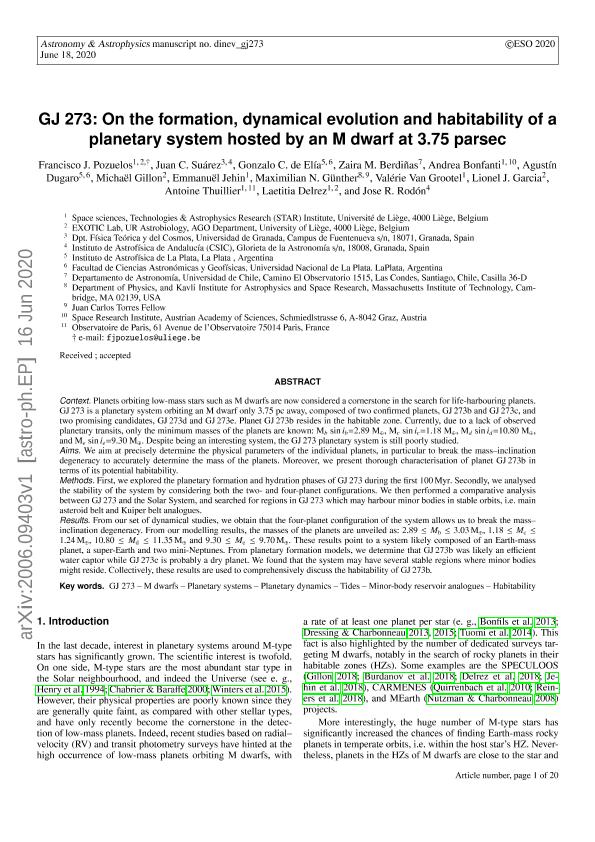Artículo
GJ 273: On the formation, dynamical evolution, and habitability of a planetary system hosted by an M dwarf at 3.75 parsec
Pozuelos, F. J.; Suárez, J. C.; de Elía, G. C.; Berdiñas, Z.; Bonfanti, A.; Dugaro, Agustin ; Guillon, M.; Jehin, E.; Mantilla Alarcon, Gunther Alfredo
; Guillon, M.; Jehin, E.; Mantilla Alarcon, Gunther Alfredo ; Abad Santos, Natalia Vanesa
; Abad Santos, Natalia Vanesa ; Garcia, Lorena Claudia
; Garcia, Lorena Claudia ; Thuillier, A.; Delrez, L.; Rodón, Julieta Stefanía
; Thuillier, A.; Delrez, L.; Rodón, Julieta Stefanía
 ; Guillon, M.; Jehin, E.; Mantilla Alarcon, Gunther Alfredo
; Guillon, M.; Jehin, E.; Mantilla Alarcon, Gunther Alfredo ; Abad Santos, Natalia Vanesa
; Abad Santos, Natalia Vanesa ; Garcia, Lorena Claudia
; Garcia, Lorena Claudia ; Thuillier, A.; Delrez, L.; Rodón, Julieta Stefanía
; Thuillier, A.; Delrez, L.; Rodón, Julieta Stefanía
Fecha de publicación:
09/2020
Editorial:
EDP Sciences
Revista:
Astronomy and Astrophysics
ISSN:
0004-6361
Idioma:
Inglés
Tipo de recurso:
Artículo publicado
Clasificación temática:
Resumen
Context. Planets orbiting low-mass stars such as M dwarfs are now considered a cornerstone in the search for planets with thepotential to harbour life. GJ 273 is a planetary system orbiting an M dwarf only 3.75 pc away, which is composed of two confirmedplanets, GJ 273b and GJ 273c, and two promising candidates, GJ 273d and GJ 273e. Planet GJ 273b resides in the habitable zone.Currently, due to a lack of observed planetary transits, only the minimum masses of the planets are known: Mb sin ib=2.89 M⊕ ,Mc sin ic =1.18 M⊕, Md sin id =10.80 M⊕ , and Me sin ie =9.30 M⊕ . Despite its interesting character, the GJ 273 planetary system hasbeen poorly studied thus far.Aims. We aim to precisely determine the physical parameters of the individual planets, in particular, to break the mass?inclinationdegeneracy to accurately determine the mass of the planets. Moreover, we present a thorough characterisation of planet GJ 273b interms of its potential habitability.Methods. First, we explored the planetary formation and hydration phases of GJ 273 during the first 100 Myr. Secondly, we analysedthe stability of the system by considering both the two- and four-planet configurations. We then performed a comparative analysisbetween GJ 273 and the Solar System and we searched for regions in GJ 273 which may harbour minor bodies in stable orbits, that is,the main asteroid belt and Kuiper belt analogues.Results. From our set of dynamical studies, we find that the four-planet configuration of the system allows us to break the mass?inclination degeneracy. From our modelling results, the masses of the planets are unveiled as: 2.89 ≤ Mb ≤ 3.03 M⊕ , 1.18 ≤ Mc ≤1.24 M⊕ , 10.80 ≤ Md ≤ 11.35 M⊕ , and 9.30 ≤ Me ≤ 9.70 M⊕. These results point to a system that is likely to be composed of anEarth-mass planet, a super-Earth and two mini-Neptunes. Based on planetary formation models, we determine that GJ 273b is likelyan efficient water captor while GJ 273c is probably a dry planet. We find that the system may have several stable regions where minorbodies might reside. Collectively, these results are used to offer a comprehensive discussion about the habitability of GJ 273b.
Archivos asociados
Licencia
Identificadores
Colecciones
Articulos(IALP)
Articulos de INST.DE ASTROFISICA LA PLATA
Articulos de INST.DE ASTROFISICA LA PLATA
Citación
Pozuelos, F. J.; Suárez, J. C.; de Elía, G. C.; Berdiñas, Z.; Bonfanti, A.; et al.; GJ 273: On the formation, dynamical evolution, and habitability of a planetary system hosted by an M dwarf at 3.75 parsec; EDP Sciences; Astronomy and Astrophysics; 641; A23; 9-2020; 1-19
Compartir
Altmétricas



